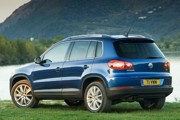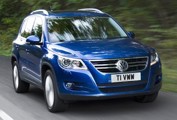Review
It can’t have escaped your notice that there have been a fair few new SUV models launched over the past few months.
Some are from established players, while others are from names whose brand has no standing in the sector.
Some will succeed in the market, while others will flounder in the mud.
One thing you can guarantee, though, is that the Volkswagen Tiguan will succeed. It may be arriving at the party while the port and cheese is being served, but there’s no doubt it has all the essentials that buyers in this sector desire...
Right badge?
Check.
Chunky styling?
Check.
Doesn’t feel like a mud-plugger to drive?
Check.
But it’s not just drivers who will appreciate the newcomer from Volkswagen.
Fleet managers will welcome its performance on the spreadsheet, too.
With a residual value prediction of 47% it means competitive leasing rates and the availability of the car to a wider group of people.
And thanks to the new common rail 2.0-litre TDI turbodiesel engine fitted in this test model, its fuel returns are not horrendous.
Driven with some degree of restraint it should top 35mpg on a regular basis, which isn’t bad for a vehicle of this type.
It’s not going to convince the green lobby, but it seems not everyone is that bothered if you look at the number of SUVs sold in the UK every year.
This new engine is slightly more powerful than the unit it replaces, and is also more refined.
Clatter at start-up has been reduced and once on the road the engine settles into a subdued tone.
There’s also been a big effort to cut wind noise, a problem for vehicles of this size and shape.
The effort has been worthwhile with the Tiguan offering a refined driving experience.
It also drives well for an SUV, although it doesn’t match Honda’s CR-V for on-road refinement and handling. However, the Tiguan manages to reduce body roll and offers a compliant ride.
The interior will be familiar to any Volkswagen owner, with generic buttons, switches and dials borrowed from the Golf and Passat. This is no bad thing, and interior build quality is good.
The interior is also very light and roomy, with a high roof and deep glass area.
The rear seats can also be slid forwards and backwards to either boost luggage space or rear legroom.
Standard equipment is decent, with our SE-spec test car coming with 17-inch alloy wheels, air conditioning, MP3 stereo, leather steering wheel and gearknob and some ‘lifestyle’ touches such as drawers under the front seats and folding tables on the back of the front seats.
Positives:
- Strong RV
- Good to drive
- Well equipped
- Styling
Negatives:
- Running costs
- Late to the party?
Three rivals to consider
Honda CR-V 2.2 I-CTDi ES
Land Rover Freelander 2.2 TD4 S
Nissan X-Trail 2.0 dCi Sport
P11D price
Apart from the entry-level Freelander, all of these cars are in mid-spec trim.
This makes the Land Rover look expensive.
All have off-road ability, although the Freelander lacks the full off-road hardware of its higher-spec siblings such as hill descent control.
Freelander: £20,705
CR-V: £21,202
X-Trail: £22,240
Tiguan: £21,545
Emissions and tax rates
With by far the lowest CO2 emissions and the second-cheapest price tag the Honda easily wins here.
The CR-V will cost a 40% taxpayer £177 a month in benefit-in-kind tax, compared to £200 for the Freelander, £201 for the Tiguan and £205 for the Nissan.
CR-V: 173g/km/25%
Tiguan: 189g/km/28%
X-Trail: 190g/km/29%
Freelander: 194g/km/29%
SMR cost
The Nissan and Honda will be the most expensive in terms of service, maintenance and repair costs due to their shorter service intervals.
Both will require a visit to the garage every 12,500 miles, whereas the Land Rover can go for up to 15,000 miles.
The Tiguan has variable servicing intervals.
X-Trail: 3.77 (pence per mile) / £2,262 (60,000 mile total)
CR-V: 4.09/£2,454
Tiguan: 4.43/£2,658
Freelander: 4.46/£2,676
Depreciation cost
The SUV sector is particularly susceptible to fashion, so being the new kid on the block has a distinct advantage.
In the case of the Tiguan, this means an RV prediction from CAP of 47%, easily putting it out in front. The Honda retains 45% and the Land Rover and Nissan 43%.
Tiguan: 19.11 (pence per mile)/ £11,466 (60,000 miles total)
Freelander: 19.21/£11,526
CR-V: 19.50/£11,700
X-Trail: 19.56/£11,736
Wholelife cost
The Honda’s performance in the fuel cost section effectively secures it the victory here, even though the Tiguan betters it on depreciation and the Nissan costs less in SMR terms.
At under 24ppm the CR-V is more than a penny per mile ahead of the Volkswagen.
CR-V: 33.92/£20,352
X-Trail: 34.62/£20,772
Tiguan: 35.00/£21,000
Freelander: 35.59/£21,354
Verdict
This sector is more about fashion than anything else and potential buyers will want to be seen in the latest model.
But running costs and driver taxation are also serious considerations.
Which means that this contest comes down to two cars – the Volkswagen Tiguan and Honda CR-V.
Both are stylish, well equipped and well built, and both have a badge which will meet the requirements of image - conscious SUV drivers.
The Honda has the edge on paper, with much lower benefit-in-kind bills and a significant advantage in running costs. For these reasons it sneaks the win from the Tiguan.
WINNER: Honda CR-V 2.2 i-CTDi ES


















Login to comment
Comments
No comments have been made yet.